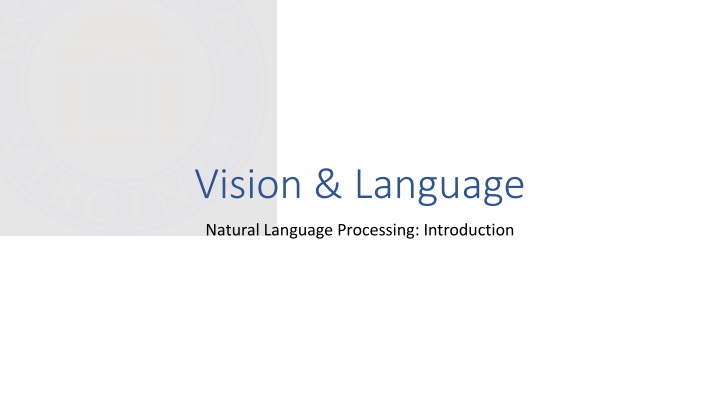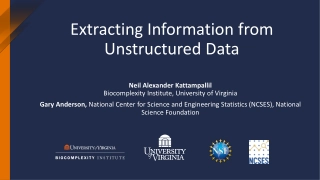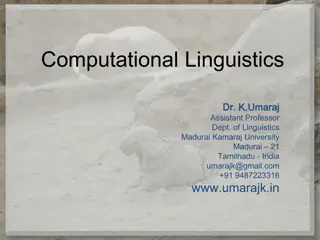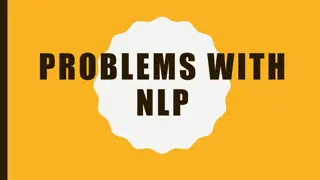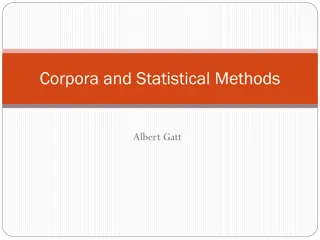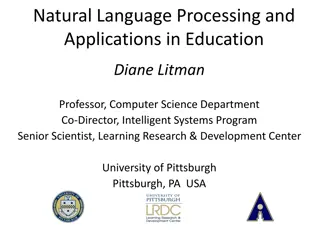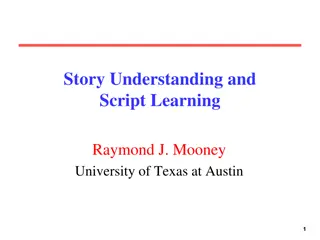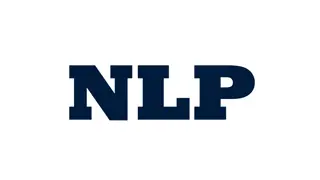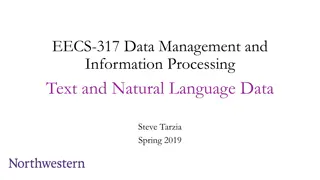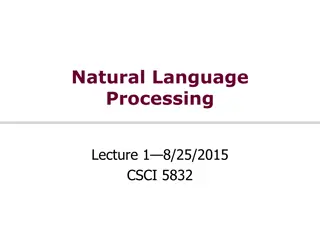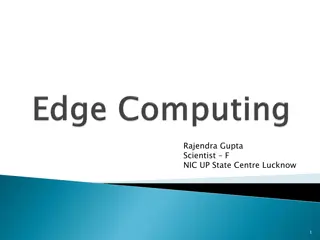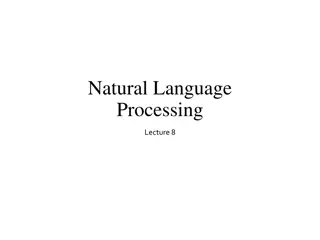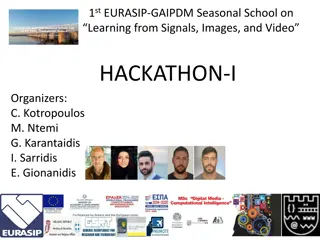Challenges in Natural Language Processing Explained
Natural Language Processing (NLP) involves automatic reasoning over text, presenting unique challenges like understanding language nuances and complexities. This introductory overview delves into the fundamentals of NLP, highlighting common tasks such as language modeling and ML representations. Delve into the complexities of NLP with a focus on understanding key principles and challenges in this rapidly evolving field.
Download Presentation

Please find below an Image/Link to download the presentation.
The content on the website is provided AS IS for your information and personal use only. It may not be sold, licensed, or shared on other websites without obtaining consent from the author.If you encounter any issues during the download, it is possible that the publisher has removed the file from their server.
You are allowed to download the files provided on this website for personal or commercial use, subject to the condition that they are used lawfully. All files are the property of their respective owners.
The content on the website is provided AS IS for your information and personal use only. It may not be sold, licensed, or shared on other websites without obtaining consent from the author.
E N D
Presentation Transcript
Vision & Language Natural Language Processing: Introduction
First Assignment To be released over the weekend (due within the following week) 1
Today What is Natural Language Processing? Why is it hard? Common Tasks in NLP Language Modeling Word and Sentence representations for ML 2
Natural Language Processing The study of automatic reasoning over text / language 3
Challenges in Natural Language Understanding: 53 305))6*;4826)4 .)4 );806*;48 8 60))85;;]8*;: *8 83(88)5* ;46(;88*96 *?;8)* (;485);5* 2:* (;4956*2(5* 4)8 8*;4069285);)6 8)4 ;1( 9;48081;8:8 1;48 85;4)485 528806*81( 9;48;(88;4 ( ?34;48)4 ;161;:188; ?; Any idea about what does it mean the text above?
Challenges in Natural Language Understanding: 53 305))6*;4826)4 .)4 );806*;48 8 agoodglassinthebishopshostelinthede 60))85;;]8*;: *8 83(88)5* ;46(;88*96 vilsseattwentyonedegreesandthirteenmi *?;8)* (;485);5* 2:* (;4956*2(5* 4)8 nutesnortheastandbynorthmainbranchse 8*;4069285);)6 8)4 ;1( 9;48081;8:8 venthlimbeastsideshootfromthelefteyeo 1;48 85;4)485 528806*81( 9;48;(88;4 fthedeathsheadabeelinefromthetreeth ( ?34;48)4 ;161;:188; ?; roughtheshotfiftyfeetout
Challenges in Natural Language Understanding: A good glass in the bishop's hostel in the devil's seat twenty-one degrees and thirteen minutes northeast and by north main branch seventh limb east side shoot from the left eye of the death's-head a bee line from the tree through the shot fifty feet out.
The Gold-Bug This coded text is in a famous short story by Edgar Allan Poe, novelist and famous UVA dropout
Why is NLP Hard? Human Language is Ambiguous Task: Pronoun Resolution Jack drank the wine on the table. It was red and round. Jack saw Sam at the party. He went back to the bar to get another drink. Jack saw Sam at the party. He clearly had drunk too much. [Adapted from Wilks (1975)] Slide by Yejin Choi 11
Why is NLP Hard? Human Language Requires World Knowledge Task: Co-Reference Resolution The doctor hired a secretary because she needed help with new patients. The physician hired the secretary because he was highly recommended. [Our own WinoBias work at UVA/UCLA] Adapted from a slide by Yejin Choi 12
Why is NLP Hard? Human Language is Ambiguous Learning mother tongue (native language) -- you might think it s easy, but compare 5 year old V.S. 10 year old V.S. 20 year old Learning foreign languages even harder Slide by Yejin Choi 13
Is NLP really that hard? In the back of your mind, if you re still thinking My native language is so easy. How hard can it be to type all the grammar rules, and idioms, etc into a software program? Sure it might take a while, but with enough people and money, it should be doable! You are not alone! Slide from Yejin Choi
Brief History of NLP Mid 1950 s mid 1960 s: Birth of NLP and Linguistics At first, people thought NLP is easy! Researchers predicted that machine translation can be solved in 3 years or so. Mostly hand-coded rules / linguistics-oriented approaches The 3 year project continued for 10 years, but still no good result, despite the significant amount of expenditure. Mid 1960 s Mid 1970 s: A Dark Era After the initial hype, a dark era follows -- people started believing that machine translation is impossible, and most abandoned research for NLP. Slide from Yejin Choi
Brief History of NLP 1970 s and early 1980 s Slow Revival of NLP Some research activities revived, but the emphasis is still on linguistically oriented, working on small toy problems with weak empirical evaluation Late 1980 s and 1990 s Statistical Revolution! By this time, the computing power increased substantially . Data-driven, statistical approaches with simple representation win over complex hand-coded linguistic rules. Whenever I fire a linguist our machine translation performance improves. (Jelinek, 1988) 2000 s Statistics Powered by Linguistic Insights With more sophistication with the statistical models, richer linguistic representation starts finding a new value. 2010 s Neural Networks Word Embeddings Neural Language Modeling. 2018 s 2020 s --- Transformers Large Scale Language Pretraining 2030s -- ?? Adapted from slide from Yejin Choi
Ambiguity is Explosive Ambiguities compound to generate enormous numbers of possible interpretations. In English, a sentence ending in n prepositional phrases has over 2n syntactic interpretations. I saw the man with the telescope : 2 parses I saw the man on the hill with the telescope. : 5 parses I saw the man on the hill in Texas with the telescope : 14 parses I saw the man on the hill in Texas with the telescope at noon. : 42 parses I saw the man on the hill in Texas with the telescope at noon on Monday 132 parses Slide from Ray Mooney
Humor and Ambiguity Many jokes rely on the ambiguity of language: Groucho Marx: One morning I shot an elephant in my pajamas. How he got into my pajamas, I ll never know. She criticized my apartment, so I knocked her flat. Noah took all of the animals on the ark in pairs. Except the worms, they came in apples. Policeman to little boy: We are looking for a thief with a bicycle. Little boy: Wouldn t you be better using your eyes. Why is the teacher wearing sun-glasses. Because the class is so bright. Slide from Ray Mooney
Why is Language Ambiguous? Slide from Ray Mooney
Why is Language Ambiguous? Having a unique linguistic expression for every possible conceptualization that could be conveyed would make language overly complex and linguistic expressions unnecessarily long. Allowing resolvable ambiguity permits shorter linguistic expressions, i.e. data compression. Language relies on people s ability to use their knowledge and inference abilities to properly resolve ambiguities. Infrequently, disambiguation fails, i.e. the compression is lossy. Slide from Ray Mooney
Natural Languages vs. Computer Languages Ambiguity is the primary difference between natural and computer languages. Formal programming languages are designed to be unambiguous, i.e. they can be defined by a grammar that produces a unique parse for each sentence in the language. Programming languages are also designed for efficient (deterministic) parsing. Slide from Ray Mooney
Natural Language Tasks Processing natural language text involves many various syntactic, semantic and pragmatic tasks in addition to other problems. Slide from Ray Mooney
Syntactic Tasks Slide from Ray Mooney
Word Segmentation Breaking a string of characters into a sequence of words. In some written languages (e.g. Chinese) words are not separated by spaces. Even in English, characters other than white-space can be used to separate words [e.g. , ; . - : ( ) ] Examples from English URLs: jumptheshark.com jump the shark .com myspace.com/pluckerswingbar myspace .com pluckers wing bar myspace .com plucker swing bar Slide from Ray Mooney
Morphological Analysis Morphology is the field of linguistics that studies the internal structure of words. (Wikipedia) A morpheme is the smallest linguistic unit that has semantic meaning (Wikipedia) e.g. carry , pre , ed , ly , s Morphological analysis is the task of segmenting a word into its morphemes: carried carry + ed (past tense) independently in + (depend + ent) + ly Googlers (Google + er) + s (plural) unlockable un + (lock + able) ? (un + lock) + able ? Slide from Ray Mooney
German 555 --> f nfhundertf nfundf nfzig 7254 Siebentausendzweihundertvierundf nfzig
Part Of Speech (POS) Tagging Annotate each word in a sentence with a part-of- speech. I ate the spaghetti with meatballs. Pro V Det N Prep N John saw the saw and decided to take it to the table. PN V Det N Con V Part V Pro Prep Det N Useful for subsequent syntactic parsing and word sense disambiguation. Slide from Ray Mooney
Phrase Chunking Find all noun phrases (NPs) and verb phrases (VPs) in a sentence. [NP I] [VP ate] [NP the spaghetti] [PP with] [NP meatballs]. [NP He ] [VP reckons ] [NP the current account deficit ] [VP will narrow ] [PP to ] [NP only # 1.8 billion ] [PP in ] [NP September ] Slide from Ray Mooney
Syntactic Parsing Produce the correct syntactic parse tree for a sentence. Slide from Ray Mooney
Semantic Tasks Slide from Ray Mooney
Word Sense Disambiguation (WSD) Words in natural language usually have a fair number of different possible meanings. Ellen has a strong interest in computational linguistics. Ellen pays a large amount of interest on her credit card. For many tasks (question answering, translation), the proper sense of each ambiguous word in a sentence must be determined. 31 Slide from Ray Mooney
Semantic Role Labeling (SRL) For each clause, determine the semantic role played by each noun phrase that is an argument to the verb. agent patient source destination instrument John drove Mary from Austin to Dallas in his Toyota Prius. The hammer broke the window. Also referred to a case role analysis, thematic analysis, and shallow semantic parsing 32 Slide from Ray Mooney
Textual Entailment Determine whether one natural language sentence entails (implies) another under an ordinary interpretation. Slide from Ray Mooney
Textual Entailment Problems from PASCAL Challenge ENTAIL MENT TEXT HYPOTHESIS Eyeing the huge market potential, currently led by Google, Yahoo took over search company Overture Services Inc last year. TRUE Yahoo bought Overture. Microsoft's rival Sun Microsystems Inc. bought Star Office last month and plans to boost its development as a Web-based device running over the Net on personal computers and Internet appliances. Microsoft bought Star Office. FALSE The National Institute for Psychobiology in Israel was established in May 1971 as the Israel Center for Psychobiology by Prof. Joel. Since its formation in 1948, Israel fought many wars with neighboring Arab countries. Israel was established in May 1971. FALSE Israel was established in 1948. TRUE Slide from Ray Mooney
Pragmatics/Discourse Tasks Slide from Ray Mooney
Anaphora Resolution/ Co-Reference Determine which phrases in a document refer to the same underlying entity. John put the carrot on the plate and ate it. Bush started the war in Iraq. But the president needed the consent of Congress. Slide from Ray Mooney
Representation vs Computability simple & plain complex & rich intractable practical & tractable Slide from Yejin Choi
How to represent a word? one-hot encodings [1 0 0 0 0 0 0 0 0 0 ] dog 1 cat 2 [0 1 0 0 0 0 0 0 0 0 ] person 3 [0 0 1 0 0 0 0 0 0 0 ] holding 4 [0 0 0 1 0 0 0 0 0 0 ] tree 5 [0 0 0 0 1 0 0 0 0 0 ] computer 6 [0 0 0 0 0 1 0 0 0 0 ] using 7 [0 0 0 0 0 0 1 0 0 0 ] What we see
How to represent a phrase/sentence? bag-of-words representation [1 0 1 1 0 0 0 0 0 0 ] person holding dog {1, 3, 4} person holding cat {2, 3, 4} [0 1 1 1 0 0 0 0 0 0 ] person using computer {3, 7, 6} [0 0 1 0 0 1 1 0 0 0 ] computer holding person using dog tree cat person using computer person holding cat {3, 3, 7, 6, 2} [0 1 2 1 0 1 1 0 0 0 ] What we see What if vocabulary is very large?
Sparse Representation bag-of-words representation indices = [1, 3, 4] values = [1, 1, 1] person holding dog {1, 3, 4} person holding cat {2, 3, 4} indices = [2, 3, 4] values = [1, 1, 1] indices = [3, 7, 6] values = [1, 1, 1] person using computer {3, 7, 6} person using computer person holding cat {3, 3, 7, 6, 2} indices = [3, 7, 6, 2] values = [2, 1, 1, 1] What we see
Recap Bag-of-words encodings for text (e.g. sentences, paragraphs, captions, etc) You can take a set of sentences/documents and classify them, cluster them, or compute distances between them using this representation.
Problem with this bag-of-words representation my friend makes a nice meal These would be the same using bag-of-words my nice friend makes a meal
Bag of Bi-grams indices = [10132, 21342, 43233, 53123, 64233] values = [1, 1, 1, 1, 1] my friend makes a nice meal {my friend, friend makes, makes a, a nice, nice meal} indices = [10232, 43133, 21342, 43233, 54233] values = [1, 1, 1, 1, 1] my nice friend makes a meal {my nice, nice friend, friend makes, makes a, a meal} A dense vector-representation would be very inefficient Think about tri-grams and n-grams What we see
Recommended reading: n-gram language models Kai-Wei s course on Natural Language Processing http://www.cs.virginia.edu/~kc2wc/teaching/NLP16/slides/02-ngram.pdf http://www.cs.virginia.edu/~kc2wc/teaching/NLP16/slides/03-smooth.pdf Yejin Choi s course on Natural Language Processing http://www3.cs.stonybrook.edu/~ychoi/cse628/lecture/02-ngram.pdf
Problem with this bag-of-words representation my friend makes a nice meal Alternatives: Continuous Bag of Words (CBOW) Word embeddings Sequence-based representations (RNNs, LSTMs) Transformer-based representations (e.g. BERT) chicken makes a nice meal
Back to how to represent a word? Problem: distance between words using one-hot encodings always the same [1 0 0 0 0 0 0 0 0 0 ] dog 1 cat 2 [0 1 0 0 0 0 0 0 0 0 ] person 3 [0 0 1 0 0 0 0 0 0 0 ] Idea: Instead of one-hot-encoding use a histogram of commonly co-occurring words. What we see
Distributional Semantics Dogs are man s best friend. I saw a dog on a leash walking in the park. His dog is his best companion. He walks his dog in the late afternoon walking sleeps friend walks leash food park runs legs sits [3 2 3 4 2 4 3 5 6 7 ] dog What we see
Distributional Semantics [5 5 0 5 0 0 5 5 0 2 ] dog [5 4 1 4 2 0 3 4 0 3 ] cat [5 5 1 5 0 2 5 5 0 0 ] person invented window mouse mirror sleeps walks food runs legs tail This vocabulary can be extremely large What we see
Toward more Compact Representations [5 5 0 5 0 0 5 5 0 2 ] dog [5 4 1 4 2 0 3 4 0 3 ] cat [5 5 1 5 0 2 5 5 0 0 ] person invented window mouse mirror sleeps walks food runs legs tail This vocabulary can be extremely large What we see
